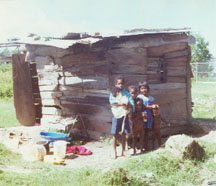-Office of US Trade Commissioner
High levels of child labour and trafficking in children persist in Guyana despite laws and regulations designed to eradicate these practices according to the Eighth Report to the US Congress on the Operations of the Caribbean Basin Economic Recovery Act.

In the section of the Report addressing social, economic and political developments in Guyana last year the document notes that the government’s commitment to the elimination of the worst forms of child labour has failed to prevent the emergence of increasing trends towards child labour particularly among children who live in the interior areas of the country. The Report cites figures published by the Bureau of Statistics and UNICEF which claim that more than 16 per cent of predominantly interior-based children between the ages of 5 and 14 work in various sectors including farming, construction, logging and fishing. According to the report some children also work as domestic servants, shop assistants, street vendors, brick makers and welders.
According to the report the practice of pressing children into service in the various economic areas persists in spite of the enactment of legislation that frowns upon the practice since, apart from what it describes as “normal police procedures” no other special institutional mechanisms exist “to investigate and address complaints related to allegations of the worst forms of child labour.
The Report notes that in April 2006 an amendment to the Young Persons and Children Act setting out the “worst forms of child labour” as work that is likely to harm the health and safety or morals of children was passed in the National Assembly but did not secure the assent of the President.

Meanwhile, the Report alludes to “reports of children involved in the illicit drug trade and commercial sexual exploitation,” adding that trafficking in children is a problem, particularly among young Amerindian girls who are trafficked internally.
According to the Report while UNICEF and the ILO’s Programme for the Elimination of Child Labour are currently supporting the Government of Guyana’s efforts to fight child labour, Guyana has no comprehensive policy for the elimination of the worst forms of child labour.
The report applauds what it says are “significant” efforts made by government to combat trafficking in persons including the passage of counter-trafficking legislation and the creation of a Unit within the Ministry of Labour, Human Services and Social Security to address the issue of human trafficking. The Report also alludes to the setting up within the Ministry of Home Affairs in 2007 of a national inter-agency task force to help combat trafficking in persons. The Report says that during 2009 government enhanced its assistance to victims, augmented training for law enforcement officials and initiated a nation-wide network of community focal points for identifying victims and prosecuting perpetrators. According to the Report, however, these initiatives notwithstanding the authorities have failed so far to convict offenders under counter-trafficking legislation.
